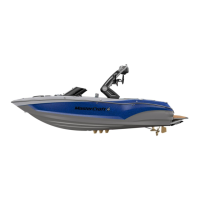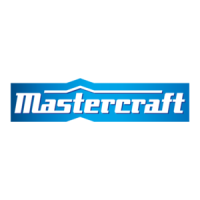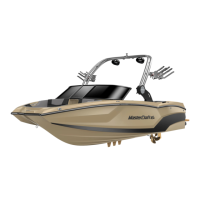15
/
2023 OWNER’S MANUAL
Fire extinguishers require periodic maintenance. Monthly, each
fire extinguisher on your boat should be examined to be sure that
the seals and tamper indicators are not broken or missing.
The pressure gauges or indicators, if applicable, should read in
the operable range. There should be no obvious physical damage,
rust, corrosion, leakage or clogged nozzles. Additionally, if the
extinguisher has not been used, it should be weighed annually to
assure that the minimum weight as stated on the label still exists.
Any fire extinguisher that has been partially emptied must be
replaced as soon as possible.
In an automatic/manual system, ensure the pin inserted to protect
the system at the helm during transit from the factory (pictured
above) has been pulled to activate the system. This is part of
dealer preparation, but it is the responsibility of the boat owner to
ensure that the system is functional.
FIRE SUPPRESSION
AND EXTINGUISHING
All MasterCraft boats are equipped with an automatic fire
suppression system. The automatic system operates from
sensors in the engine room and will automatically release a clean-
agent, gaseous chemical that does not leave residue behind.
It is also possible to activate the system manually on the domestic
boats only. Pull the pin with the red tag (pictured to left), and then
pull the red fire handle to set the system in operation.
(International boats are automatic only.)
In case of an engine compartment fire, shut down the engine
and blowers before manual discharge, or immediately following
the automatic discharge. Boats are equipped with a discharge
indication light at the instrument panel or on the video display
gauge at the helm.
After the suppression system has been used, the fire extinguisher
canister will be empty. The boat owner/operator should have the
canister replaced as soon as possible.
MasterCraft boats have also been specified to carry a hand-held
2.5 lb. monoammonium phosphate expellant (dry chemical) unit,
which is rated Class A (trash, wood and paper), Class B (flammable
liquids, fuel, gas) and Class C (energized electrical equipment).
